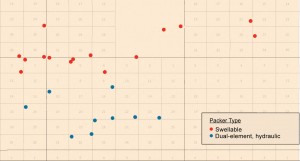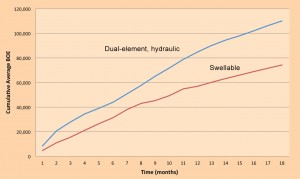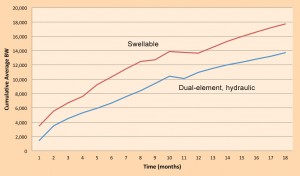Hydraulic-set packers may boost production
Installation, thermal stability, stress on formation among key considerations in tool selection for open-hole multistage fracturing
By Dan Themig, Packers Plus Energy Services
A number of different justifications can be made for decisions on tool selection for open-hole multistage fracturing. More specifically, what type of packer provides reliable isolation and sufficient strength and durability to handle the high-pressure conditions required for multistage fracturing?

Comments – such as “they’re not great, but they’re good enough” – have been made regarding certain types of packers. Such comments indicate that the tools selected may not be well-suited for the application.
What is the cost of settling for “good enough”? This article presents a recent production study that begins to shed light on whether this is an acceptable compromise. In addition, studies have been completed regarding open-hole packers of various designs and builds to investigate whether they provide suitable isolation from an engineering standpoint (Rivenbark and Dickenson, 2011). A thorough understanding of these issues could prove important for decisions in field development.
Theoretical analyses have also been done on the importance of having annular isolation with sufficient pressure rating to effectively compartmentalize a horizontal well for multistage fracturing. However, the critical factor is how the isolation method performs in a well, or more importantly, in full field development, and what type of production results are achieved. Is there a difference?
Based on the following studies, it appears that the choice of isolation method can affect not only the efficacy of stimulation but also well production volumes.
Evaluating packer technologies
When determining which type of packer is appropriate for open-hole, multistage fracturing applications, many issues need to be considered. Simplicity alone may not warrant consideration when evaluating from an engineering standpoint. What is key is that isolation is consistently achieved, both during setting conditions and fracturing treatments.
The key factors that should be considered are discussed below.
Operation and installation
A key consideration when selecting packer type is operation and installation effectiveness. A dual-element, hydraulic-set, mechanical packer is relatively short (approximately 5 ft) with a reduced-diameter center section, allowing for installation in wells with high dogleg severity and, in some cases, even short-radius wells.
Additionally, the dual-element, hydraulic packer contains a sealing element at both ends, and the design of the element effectively isolates a much longer section than the element alone (approximately 4 ft). In this way, there are elements on both the high-pressure and low-pressure sides.
During high-pressure operation, forces from the high-pressure side will force-load into both elements and essentially provide a self-correcting and appropriate sealing force against the formation.
To set, dual-element, hydraulic packers require circulating a setting ball down to a circulation sub at the end of the system while simultaneously removing drilling mud and circulating the horizontal section to the completion fluid. Hydraulic pressure inside the system is then increased by pumping fluid from surface, and, at a specific pressure, the packers along the system will set.
In contrast, a swellable elastomer packer designed to efficiently handle fracturing pressures will be very long due to the length of elastomer required to attain high-pressure isolation (typically 10 ft to 20 ft). The diameter of the swellable elastomer will be the same along the entire packer. From an operational standpoint, long-sealing element packers can be difficult to install in wells with high dogleg severity. In addition, once activated, swellable elastomers are typically low-strength (approximately 40 durometer) and relatively soft. Friction coefficients for installing swellables can be fairly high.
Swellable elastomers also require a considerable amount of time from installation until they are fracture-ready. This can increase costs significantly in environments where rig costs are high, such as deepwater. Setting swellables requires circulating the horizontal section over to an appropriate fluid to make the elastomers swell.
In addition, field experience in lower bottomhole temperature environments shows that swell time may be highly inconsistent. In one test environment in a naturally fractured formation, the anticipated swell time for the swellables was three days. The operator set up the completion so that he could maintain the ability to circulate, thus verifying packer setting (swelling).
Due to the combination of fluid leak-off into the natural fractures and a limited bottomhole temperature, the operator was able to continue circulating for six weeks following installation of the swellables.
Thermal stability
The thermal stability of packer elements is another key consideration for successfully establishing mechanical diversion during fracturing operations. The importance of thermal stability was demonstrated by an operator who tested a series of open-hole packers under temperature-dynamic conditions. The test required the attainment of 10,000-psi pressure capability, as well as the ability to hold pressure during a cool-down from 300°F (simulating bottomhole temperature) to 120°F (simulating cool-down during fracture operations).
During the test, a phenomenon called “thermal shock effect” was observed in all swellables tested (three major suppliers). While all swellables, given enough length, were able to withstand 10,000 psi, when cool-down began, the elastomers experienced a thermal shock, which caused pressure failure in every case tested. When tested under identical conditions, the dual-element, hydraulic packer proved able to maintain 10,000-psi differential while cooling from 300°F to 120°F.
Prior to horizontal multistage fracturing, a considerable amount of literature established the suitability of swellables. At that time, knowledge of the thermal shock effect was known. One technical paper stated, “The contraction will lead to a drop in internal element pressure; ultimately, it will result in a physical shrinkage, and the pressure seal will be lost” (Evers et al., 2009). The paper indicated that the thermal coefficient of expansion and contraction for swelling elastomers is 10 times higher than it is for steel. In essence, without sufficient time to swell, isolation may be lost as the elastomer cools down with pressure differential.
Stress on formation
The amount of stress a packer puts on the formation should also be evaluated when determining the appropriate isolation device for open-hole multistage fracturing. Several technologies are available to provide mechanical isolation in open-hole wellbores.
A recent paper compared several of these technologies, including swellable, inflatable and hydraulic-set mechanical packers (Roundtree et al, 2009). The paper stated that an open-hole hydraulic-set mechanical packer will impart 6,000 psi of stress on the formation rock. Although it was determined that the hydraulic-set, mechanical packer imparted sufficiently high stress on the rock to cause failure of the rock, more effective mechanical-set hydraulic packers do not exhibit these types of stresses.
Verified by Houston’s Stress Engineering, a dual-element, hydraulic packer (the RockSEAL II) at fracture-treatment pressure imparts only 600 psi to 800 psi. Based on their analysis, this is believed to be the appropriate stress for nearly all formation types, both soft and hard rock.
Based on empirical evidence, including the ability to maintain a 10,000-psi differential rating during fracture breakdown operations, this author believes that dual-element, hydraulic packers are the only current industry tool that will provide high-pressure isolation in nearly all conditions. In addition, if water control for future applications or water flooding are required, a hydraulic-set packer with suitable elastomers has been the standard of the industry for more than 50 years.

Production comparison study
This study involved 24 wells in close proximity in the Bakken formation in North Dakota. The wells were drilled and completed during the same time period and used similar fracturing programs. The primary dividing point for this data was that one operator exclusively used swellables while the other operator used dual-element, hydraulic packers. Both large-scale and side-by-side well comparisons were conducted. In addition, water production was studied for both types of isolation packers.
Figure 1 shows the study area, with swellables being used in one segment of the field by one operator and dual-element, hydraulic packers in the other segment of the field by a second operator. Figure 2 presents the first 18 months of cumulative production. There is a clear difference between recovery using the two different isolation technologies.
The wells completed with dual-element, hydraulic packers outperformed the wells completed with swellables by nearly 50% – 106,300 bbls versus 71,500 bbls – a difference of 35,000 bbls. Side-by-side well comparisons showed a similar 50% increase in recoveries for wells completed with dual-element, hydraulic versus swellable packers (data not shown).

Next, a comparison was made regarding water production in these wells. The wells completed with swellable packers produced considerably more water than those completed with dual-element, hydraulic packers (Figure 3). The additional water could be due to multiple fracture treatments being placed in a single area. In other words, instead of initiating a new fracture, which would contribute to higher recovery, an interval that has already been stimulated is refractured.
This causes two problems: first, a loss of production from the area where isolation was not achieved; second, fracturing an interval twice, or even three times, can result in too much height growth, causing the fracture to extend into water-bearing intervals.
Key conclusions from the study are:
• Effective mechanical diversion is extremely important for open-hole multistage fracturing;
• Dual-element, hydraulic packers have a significant performance advantage over swellables during hydraulic fracturing operations;
• A suitably designed dual-element, hydraulic packer provides appropriate force on the rock and will not cause formation failure;
• The thermal shock effect may cause packer element failure of swellables during fracturing operations;
• Isolation failure during fracturing operations can cause excessive water production and ineffective stimulation resulting in reduced production;
• Dual-element, hydraulic packers are the most effective method of achieving mechanical diversion during fracturing operations.
Conclusions
A “good enough” choice of isolation technologies for field development using open-hole multistage fracturing can prove costly. In the production comparison study presented here, wells completed with dual-element, hydraulic packers exhibited a 50% increase in productivity over those completed with swellables. The thermal shock effect may have resulted in lost stages and overstimulation in some parts of the horizontal.
With the theoretical and empirical evidence presented in this article illustrating the benefits of dual-element, hydraulic packers, “good enough” may be a poor selection criterion.
RockSEAL is a registered trademark of Packers Plus Energy Services.
References
Evers, R., Young, D., Vargus, G. and Solhaug, K. 2009. Design Methodology for Swellable Elastomer Packers in Fracturing Operations. Paper OTC 20157 presented at the 2009 Offshore Technology Conference in Houston, Texas, 4-7 May 2009.
Rivenbark, M. and Dickenson, B. 2011. New Openhole Technology Unlocks Unconventional Oil and Gas Reserves Worldwide. Paper SPE 147927 presented at the2011 SPE Asia Pacific Oil and Gas Conference and Exhibition in Jakarta, Indonesia, 20-22 September 2011.
Roundtree, R., Eberhard, M. and Barree, R. 2009. Horizontal, Near-Wellbore Stress Effects on Fracture Initiation. Paper SPE 123589 presented at the 2009 SPE Rocky Mountain Petroleum Technology Conference in Denver, Colo., 14-16 April 2009.




